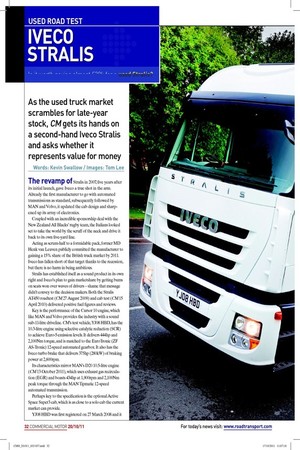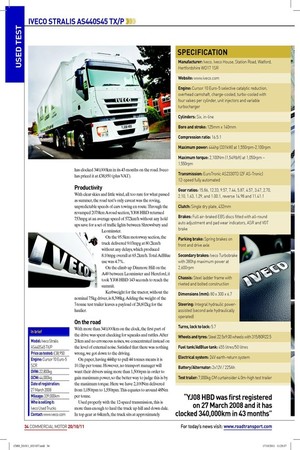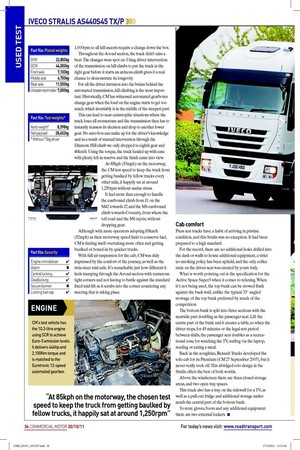As the used truck market scrambles for late-year stock, CM
Page 22

Page 24

Page 26

If you've noticed an error in this article please click here to report it so we can fix it.
gets its hands on a second-hand Iveco Stralis and asks whether it represents value for money
Words: Kevin Swallow / Images: Tom Lee
The revamp of Stralis in 2007, ive years after its initial launch, gave Iveco a true shot in the arm. Already the irst manufacturer to go with automated transmissions as standard, subsequently followed by MAN and Volvo, it updated the cab design and sharpened up its array of electronics.
Coupled with an incredible sponsorship deal with the New Zealand All Blacks’ rugby team, the Italians looked set to take the world by the scruff of the neck and drive it back to its own ive-yard line.
Acting as scrum-half to a formidable pack, former MD Henk van Leuven publicly committed the manufacturer to gaining a 15% share of the British truck market by 2011. Iveco has fallen short of that target thanks to the recession, but there is no harm in being ambitious.
Stralis has established itself as a sound product in its own right and Iveco’s plan to gain marketshare by getting bums on seats won over waves of drivers – shame that message didn’t convey to the decision makers. Both the Stralis AT450 roadtest (CM 27 August 2009) and cab test (CM 15 April 2010) delivered positive fuel igures and reviews.
Key is the performance of the Cursor 10 engine, which like MAN and Volvo provides the industry with a sound sub-11-litre driveline. CM’s test vehicle, YJ08 HBD, has the 10.3-litre engine using selective catalytic reduction (SCR) to achieve Euro-5 emission levels. It delivers 444hp and 2,100Nm torque, and is matched to the EuroTronic (ZF AS-Tronic) 12-speed automated gearbox. It also has the Iveco turbo brake that delivers 375hp (280kW) of braking power at 2,600rpm.
Its characteristics mirror MAN’s D20 10.5-litre engine (CM 13 October 2011), which uses exhaust gas recirculation (EGR) and boasts 434hp at 1,900rpm and 2,100Nm peak torque through the MAN Tipmatic 12-speed automated transmission.
Perhaps key to the speciication is the optional Active Space Super3 cab, which is as close to a solo cab the current market can provide.
YJ08 HBD was irst registered on 27 March 2008 and it has clocked 340,000km in its 43 months on the road. Iveco has priced it at £38,950 (plus VAT).
Productivity
With clear skies and little wind, all too rare for what passed as summer, the road test’s only caveat was the roving, unpredictable speeds of cars towing en route. Through the revamped 207.9km A-road section, YJ08 HBD returned 7.53mpg at an average speed of 57.2km/h without any hold ups save for a set of trafic lights between Shrewsbury and Leominster.
On the 95.5km motorway section, the truck delivered 9.03mpg at 80.2km/h without any delays, which produced 8.10mpg overall at 65.2km/h. Total AdBlue use was 4.7%.
On the climb up Dinmore Hill on the A49 between Leominster and Hereford, it took YJ08 HBD 143 seconds to reach the summit.
Kerbweight for the tractor, without the nominal 75kg driver, is 8,398kg. Adding the weight of the 7-tonne test trailer leaves a payload of 28,602kg for the haulier.
On the road
With more than 340,000km on the clock, the irst part of the drive was spent checking for squeaks and rattles. After 20km and no erroneous noises, we concentrated instead on the level of external noise. Satisied that there was nothing wrong, we got down to the driving.
On paper, having 444hp to pull 44 tonnes means it is 10.1hp per tonne. However, no transport manager will want their drivers using more than 1,500rpm in order to gain maximum power, so the better way to judge this is by the maximum torque. Here we have 2,100Nm delivered from 1,050rpm to 1,550rpm. This equates to around 48Nm per tonne.
Used properly with the 12-speed transmission, this is more than enough to haul the truck up hill and down dale. In top gear at 64km/h, the truck sits at approximately 1,000rpm so all hill ascents require a change down the box.
Throughout the A-road section, the truck didn’t miss a beat. The changes were spot on. Using driver intervention of the transmission on hill climbs to put the truck in the right gear before it starts an arduous climb gives it a real chance to demonstrate its longevity.
For all the driver intrusion into the brains behind the automated transmission, hill climbing is the most important. Historically, CM has witnessed automated gearboxes change gear when the load on the engine starts to get too much, which invariably is in the middle of the steepest part.
This can lead to near catastrophic situations where the truck loses all momentum and the transmission then has to instantly reassess its decision and drop to another lower gear. No auto-box can make up for the driver’s knowledge and as a result of manual intervention through the Dinmore Hill climb we only dropped to eighth gear and 40km/h. Using the torque, the truck hauled up with ease with plenty left in reserve and the inish came into view.
At 85kph (53mph) on the motorway, the CM test speed to keep the truck from getting baulked by fellow trucks every other mile, it happily sat at around 1,250rpm without undue stress.
It had more than enough to handle the eastbound climb from J1 on the M42 towards J2 and the M6 eastbound climb towards Coventry, from where the toll road and the M6 rejoin, without dropping gear.
Although with more operators adopting 83km/h (52mph) as their motorway speed limit to conserve fuel, CM is inding itself overtaking more often and getting baulked or boxed-in by quicker trucks.
With full air suspension for the cab, CM was duly impressed by the comfort of the journey, as well as the twin-steer mid-axle. It’s remarkable just how different it feels tramping through the A-road section with numerous tight corners and not having to battle against the standard ixed mid-lift as it scrubs into the corner countering any steering that is taking place.
Cab comfort
Press test trucks have a habit of arriving in pristine condition, and this Stralis was no exception. It had been prepared to a high standard.
For the record, there are no additional holes drilled into the dash or walls to house additional equipment, a strict no smoking policy has been upheld, and the only coffee stain on the driver seat was created by yours truly.
What is worth pointing out is the speciication for the Active Space Super3 when it comes to relaxing. When it’s not being used, the top bunk can be stowed lush against the back wall, unlike the typical 33° angled stowage of the top bunk preferred by much of the competition.
The bottom bunk is split into three sections with the nearside part doubling as the passenger seat. Lift the centre part of the bunk and it creates a table, so when the driver stops, for 45 minutes or the legal rest period between shifts, the passenger seat doubles as a recreational zone for watching the TV, suring via the laptop, reading or eating a meal.
Back in the noughties, Renault Trucks developed the solo cab for its Premium (CM 27 September 2007), but it never really took off. This abridged solo design in the Stralis offers the best of both worlds.
Above the windscreen there are three closed storage areas, and two open tray spaces.
This truck also has a tray on the sidewall for a TV, as well as a pull-out fridge and additional storage underneath the central part of the bottom bunk.
To store gloves, boots and any additional equipment there are two external lockers. ■










































